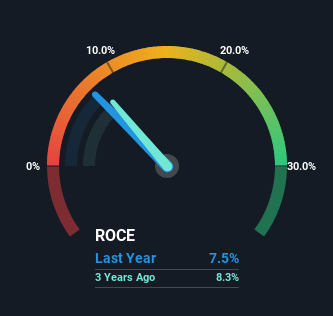- United States
- /
- Media
- /
- NasdaqGS:STGW
There's Been No Shortage Of Growth Recently For Stagwell's (NASDAQ:STGW) Returns On Capital

If we want to find a potential multi-bagger, often there are underlying trends that can provide clues. Ideally, a business will show two trends; firstly a growing return on capital employed (ROCE) and secondly, an increasing amount of capital employed. If you see this, it typically means it's a company with a great business model and plenty of profitable reinvestment opportunities. So when we looked at Stagwell (NASDAQ:STGW) and its trend of ROCE, we really liked what we saw.
Return On Capital Employed (ROCE): What Is It?
For those who don't know, ROCE is a measure of a company's yearly pre-tax profit (its return), relative to the capital employed in the business. To calculate this metric for Stagwell, this is the formula:
Return on Capital Employed = Earnings Before Interest and Tax (EBIT) ÷ (Total Assets - Current Liabilities)
0.075 = US$199m ÷ (US$3.9b - US$1.2b) (Based on the trailing twelve months to June 2023).
Therefore, Stagwell has an ROCE of 7.5%. In absolute terms, that's a low return but it's around the Media industry average of 8.1%.
See our latest analysis for Stagwell

In the above chart we have measured Stagwell's prior ROCE against its prior performance, but the future is arguably more important. If you'd like, you can check out the forecasts from the analysts covering Stagwell here for free.
What Does the ROCE Trend For Stagwell Tell Us?
We're glad to see that ROCE is heading in the right direction, even if it is still low at the moment. The data shows that returns on capital have increased substantially over the last four years to 7.5%. The company is effectively making more money per dollar of capital used, and it's worth noting that the amount of capital has increased too, by 383%. So we're very much inspired by what we're seeing at Stagwell thanks to its ability to profitably reinvest capital.
The Bottom Line
In summary, it's great to see that Stagwell can compound returns by consistently reinvesting capital at increasing rates of return, because these are some of the key ingredients of those highly sought after multi-baggers. Astute investors may have an opportunity here because the stock has declined 35% in the last year. So researching this company further and determining whether or not these trends will continue seems justified.
One more thing to note, we've identified 1 warning sign with Stagwell and understanding this should be part of your investment process.
While Stagwell isn't earning the highest return, check out this free list of companies that are earning high returns on equity with solid balance sheets.
New: Manage All Your Stock Portfolios in One Place
We've created the ultimate portfolio companion for stock investors, and it's free.
• Connect an unlimited number of Portfolios and see your total in one currency
• Be alerted to new Warning Signs or Risks via email or mobile
• Track the Fair Value of your stocks
Have feedback on this article? Concerned about the content? Get in touch with us directly. Alternatively, email editorial-team (at) simplywallst.com.
This article by Simply Wall St is general in nature. We provide commentary based on historical data and analyst forecasts only using an unbiased methodology and our articles are not intended to be financial advice. It does not constitute a recommendation to buy or sell any stock, and does not take account of your objectives, or your financial situation. We aim to bring you long-term focused analysis driven by fundamental data. Note that our analysis may not factor in the latest price-sensitive company announcements or qualitative material. Simply Wall St has no position in any stocks mentioned.
About NasdaqGS:STGW
Stagwell
Provides digital transformation, performance media and data, consumer insights and strategy, and creativity and communications services in the United States, the United Kingdom, and internationally.
Undervalued with reasonable growth potential.
Similar Companies
Market Insights
Community Narratives





